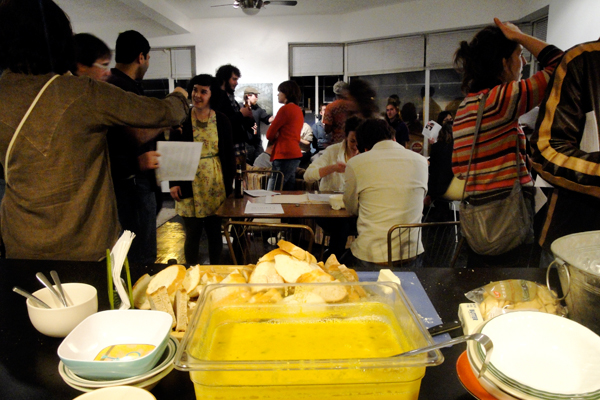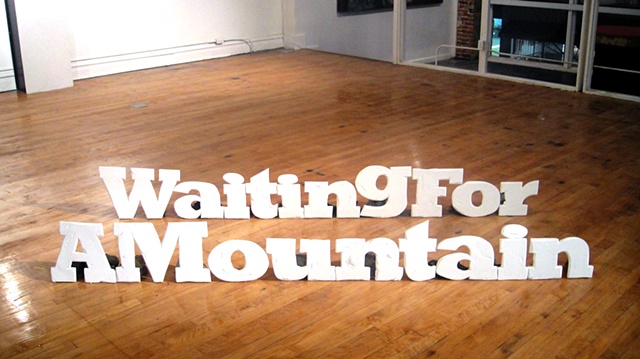
Stan Chisholm, "WaitingForAMountain," 2010. Installation at Art Dimensions Gallery, St. Louis. Chisholm is a graduate of the CAT Institute.
During my time as a guest blogger for Art21, I’ve examined various initiatives that have transformed the cultural landscape of St. Louis. Despite the city’s dwindling population, the arts are prospering in St. Louis, as evidenced by the ever-increasing number of contemporary art organizations, the abundance of creative activity on Cherokee Street, in Grand Center, Old North, and Hyde Park, and the social commitment of artists like Juan William Chávez and Theaster Gates. As I was thinking about how I’d like to wrap up my examination of the St. Louis art scene, I felt the need to more precisely pinpoint the catalyst for cultural activism within the city.
I began this formidable task by arranging meetings with culturally engaged social workers. Social work, like art, is constantly re-defining itself and expanding its perimeters. Over the past year, I’ve become increasingly aware of the growing number of Master of Social Work (MSW) graduates who, coming out of Washington University’s Brown School of Social Work, have pursued careers in the arts. The marriage of social work and contemporary art forms a crucial partnership in arts-based community development. Equipped with macro-level analysis and evaluation skills, the social workers I met with helped me better understand our current artistic movement within the broader social context of St. Louis.
First I met with Lisa Harper Chang, the Community Projects Director at the Pulitzer Foundation for the Arts. In 2007, Chang established the initial partnership between the Pulitzer and the Brown School and her contributions have since paved the way for future MSW students—such as Emily Augsburger and Megan Johnson—to fulfill their social work practicums at the Pulitzer. Next I met with Regina Martinez, an artist and social worker, who, as I mentioned in my previous post, is working with Theaster Gates and the Rebuild Foundation to start a community arts center in Pagedale, St. Louis. After that, I interviewed Claire Wolff, founder of Urban Studio Café, a non-profit coffee shop in Old North that used its proceeds for arts programming. Lastly, I met with Amanda Moore McBride, Associate Dean for Social Work at the Brown School, who explained to me that the program’s recent emphasis on cultural activism evolved from a movement from within the student body. Each of these meetings demonstrated how social workers are increasingly helping to refine the goals of community art initiatives in our city.
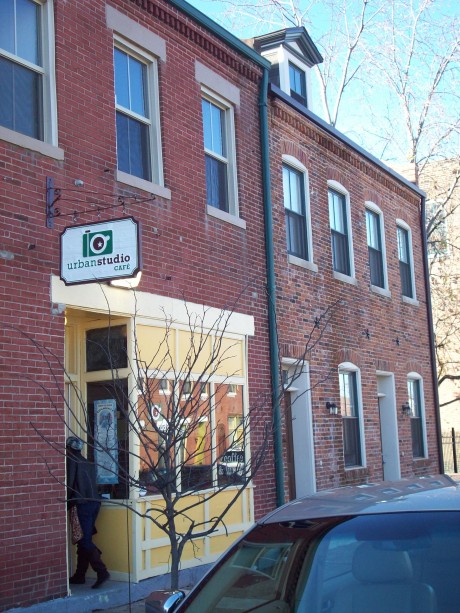
Urban Studio Café was a non-profit café that supported arts and community projects in North City. It was founded in 2009 by Claire Wolff, CAT Institute alum and MSW graduate from the Brown School of Social Work. This year, Urban Studio Café closed its doors and Old North residents have since opened a new coffee shop in its stead.
Meeting with social workers proved invaluable in my quest to identify the catalysts of cultural activism within St. Louis. During each interview, I was repeatedly advised to speak with Roseann Weiss, Director of Community Art Programs & Public Art Initiatives at the St. Louis Regional Arts Commission (RAC). Weiss, I was told, inspired many MSW candidates to seek careers in the arts. Specifically, her leadership in the Community Arts Training (CAT) Institute has instructed both artists and social service professionals on how to work together to affect positive social change through the arts. With over 200 alums, many whose names have appeared throughout my previous blog posts, the CAT Institute has become a national model for interdisciplinary community arts training. Beyond her role at RAC, Roseann Weiss is a major advocate for the arts in St. Louis, weaving together her background in contemporary art and non-profit management with her passion for community engagement.
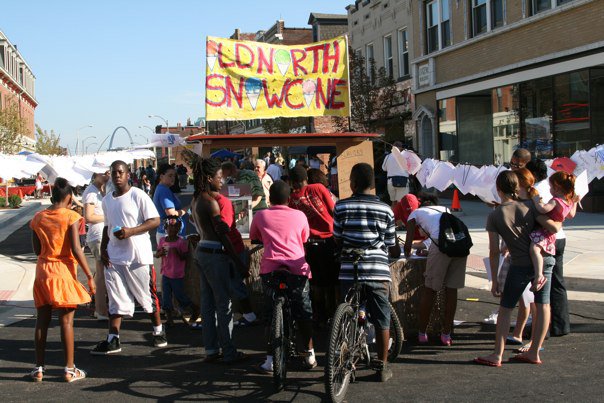
In July 2010, artist and CAT Institute alum Juan William Chávez created a snowcone stand for the grand opening of Crown Square in Old North, St. Louis. Chávez created a workshop that focused on snowcone culture and its relationship to the community. Participants created drawings in exchange for free snowcones.
Francesca Wilmott: To begin, for those unfamiliar with the Regional Arts Commission, can you share a little about its background and the role that it plays within St. Louis?
Roseann Weiss: The Regional Arts Commission (RAC) is the St. Louis area’s largest annual funder of the arts, granting about $3 million annually. In addition to financial support through grants, RAC serves as a cultural catalyst in the arts community, providing technical, promotional and other support for arts organizations of all shapes and sizes. RAC receives funding from 4/15ths of the hotel/motel room sales tax revenue from St. Louis City and County, in addition to special project grants from foundations such as the Nathan Cummings, Kresge, and Whitaker Foundations, corporations, the Missouri Arts Council, and the National Endowment for the Arts.
From its inception in 1985, the grant-making policy of RAC not only included providing funds for arts programs facilitated by arts organizations and institutions – but also for those facilitated in non-arts 501(c)(3) organizations, such as community or human service organizations. Always taking a dynamic role in the support of their grantees, RAC staff encourage arts organizations to actively seek partnerships in the greater community. With the notion to unleash the power of art outside the traditional concert halls, theaters and galleries, the Regional Arts Commission staff and community designed the core curriculum for training partners for sustainable community arts programs.
FW: How did the Community Arts Training Institute initially begin? How has the program evolved and grown with St. Louis?
RW: The Community Arts Training (CAT) Institute at RAC has been a national model since 1997 and is the oldest sustained training of its kind in the country. (It is sustained because RAC sustains it even when it hasn’t been possible to find other funds.) The CAT Institute facilitates rigorous cross-sector training of community arts partners in an annual five-month curriculum for sixteen fellows — eight artists of all disciplines and eight social service professionals, community organizers, policy makers, and educators. Among the Institute’s goals are strong arts based community programs that amplify the voices of underserved communities, regenerate neighborhoods, and create significant vehicles for positive social change.
CAT Institute fellows participate in more than 55 hours of training, which occur during intensive, two-day sessions once a month for five months and in lab project assignments. The challenging curriculum includes training on partnership and survival strategies, conflict resolution, learning styles, teaching strategies, public relations, identifying funding sources, legal and liability issues in the arts and social services, assessment techniques and advocacy. Fellows complete homework assignments of extensive reading and the development of team lab programs. The learning methods include discussions, critical response to reading assignments, site visits, reviews of case studies, interactions with the community, writing assignments, and participation in interactive projects. All CAT Institute fellows are accepted into the Institute on an underwritten basis. In other words, except for some possible costs of books (which can be borrowed), it’s free.
Characterized by its credibility, creativity, and longevity as a sustained community arts training program active for 15 years, the CAT Institute is uniquely positioned to bring together and to foster a cohort of leaders in an arts integrative approach for skill and capacity building relevant to a particular community. The CAT Institute’s core faculty includes experienced practitioners and nationally recognized advisers in the field. The CAT Institute is in an exciting phase and is expanding its scope. We organized the first At the Crossroads: Community Art & Development Convening in 2010 and will organize another in April 2012. We are also expanding the scope of the Institute. Through a grant from the Kresge Foundation, we are reshaping the curriculum to create a second way of facilitating CAT in a place-based model. In addition, we are designing a “graduate” CAT Institute for those CAT alums who want to go deeper into researching/testing/evaluating their community practice.
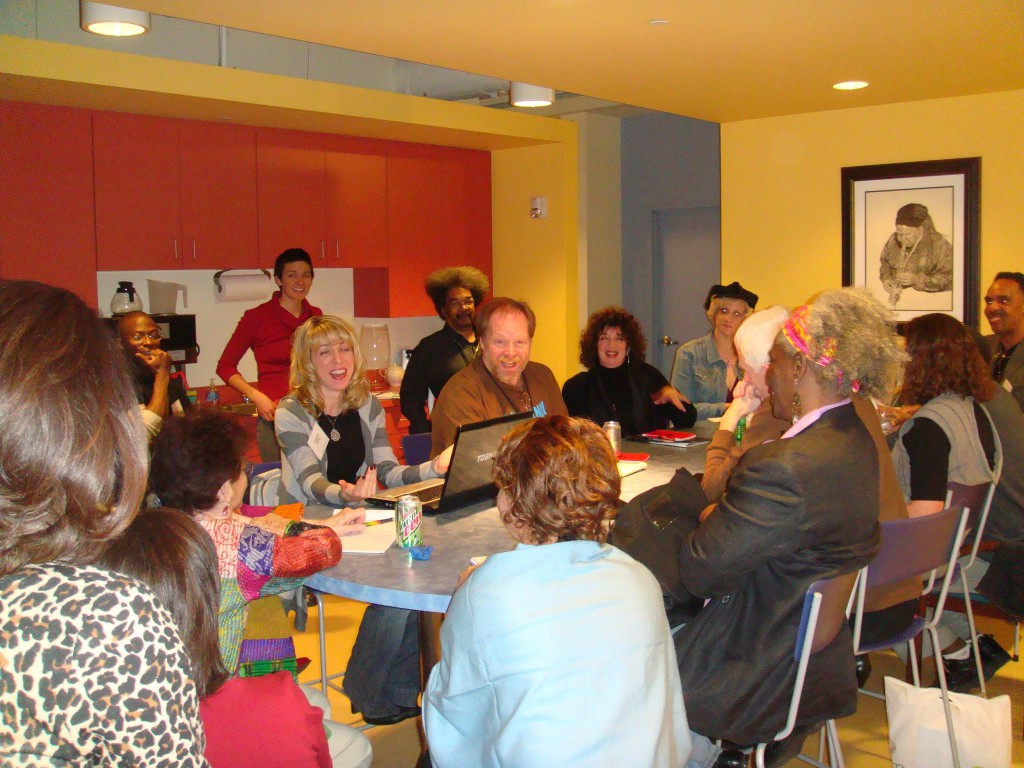
Roundtable discussion during the Regional Arts Commission's conference, At the Crossroads: A Community Arts and Development Convening, March 2010.
FW: You recently presented at the Rust Belt to Artist Belt conference in Cleveland and have witnessed cultural revitalization occurring throughout other post-industrial cities. How do you think that cultural activism in St. Louis differs from cultural initiatives in other mid-size American cities?
RW: We are too quiet about all the work going on here. We have a lot of knowledge and experience in activism and arts-based community development – in part because of the training and support available here. CAT Institute alums are embedded everywhere. I just visited Theaster Gates’s projects in St. Louis – there were at least five CAT alums directly involved in what he is doing. I look at the 12-year-old program at the art collaborative at the Peter and Paul Community Center’s transitional program for homeless men. Two CAT grads started it (an artist and a shelter manager) and sustain it and bring in other CAT grads as collaborators. These men created a performance work with the writings they did with Janie Ibur, a CAT faculty member, that never ceases to move any audience when they perform it. Or a new program in Dutchtown with CAT alums and neighborhood youth centered on creating fashion design. The lead artist and community organizer told me that the teens – both young women and men – are waiting for them when they get there in the morning. These examples are only the very tip of the amazing arts-based work going on. But some of it isn’t “sexy” projects – some of it is embedded in places like the Juvenile Detention Center or an immigrants’ organization – but they are very powerful.
###
Perhaps more than any other cultural enterprise in St. Louis, the CAT Institute has stimulated the recent growth of cultural activism, helping to redefine St. Louis’s identity through the arts.

